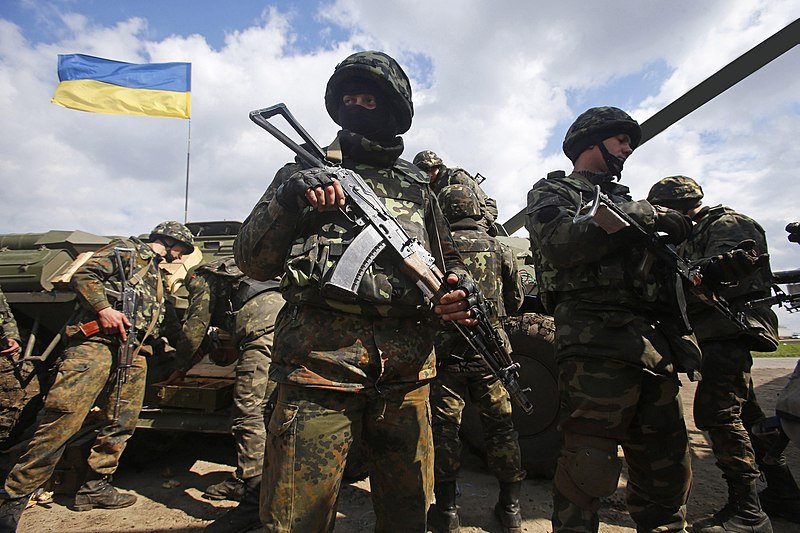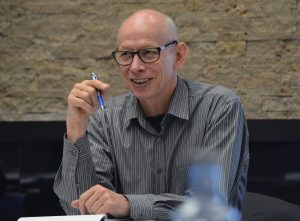*Editor’s Note: The “Views from NAU” blog series highlights the thoughts of different people affiliated with NAU, including faculty members sharing opinions or research in their areas of expertise. The views expressed reflect the authors’ own personal perspectives.
 By Björn Krondorfer
By Björn Krondorfer
Regents’ professor in the Department of Comparative Cultural Studies and director of the Martin-Springer Institute
How can we make sense of the Russian attack on the sovereign territory of the Ukraine? How can we make sense of the necessary, yet unending stream of commentaries and explanations that floods our social media and news channels? I am no expert on Ukraine, but I do follow the events closely within the context of our work at the Martin-Springer Institute. After all, in early October our institute wants to host an international symposium at NAU on the contested and unresolved legacies of the Nazi camps and the Soviet Gulag, a history that is playing out currently in the haunted political geography of Ukraine. Together with a colleague from Amsterdam—a specialist on Soviet Russia and trauma (and academic director of an institute on Russian Orthodoxy)—we will have a symposium with scholars from Eastern Europe, Israel, Germany, the Netherlands and the United States; it was postponed twice because of COVID, and perhaps it will be postponed again because of the unfolding catastrophe in the Ukraine.
In violent conflagrations, one of the first things to disappear is unfiltered truth. The lines between information, misinformation and disinformation become blurred. Disinformation—understood as the intentional spread of false information—is certainly part of the arsenal of Putin’s Russia to quell resistance at home. Russian soldiers had to surrender their cell phones before going to battle; all independent news organizations have been shut down; journalists and opponents are jailed or chased out of the country; and individuals are prosecuted for calling the war in Ukraine a “war.”
Misinformation is the unintentional dissemination of false information. It can quickly spread on social media, like the image of a destroyed building supposedly in Ukraine but actually a recycled photo from previous Israeli bombings of Gaza.
Finally, reports from the ground inform us about death and destruction, refugees and burned-out tanks, the misery of ruined cities and injured civilians. The Russian aggression and the unfolding humanitarian catastrophe have brought the European Union closer together and reaffirmed ties with the United States. But when it comes to making sense of these reports, there is little unity. Should we have known about Russia’s intentions all along? Angela Merkel, the former chancellor of Germany, said a few years ago that Putin had lost touch with reality, and the late Arizona senator John McCain warned repeatedly about the danger Ukraine was facing, especially after the Russian annexation of the Crimea in 2014. Other politicians, however, hoped that strong commercial ties with Russia (like gas pipelines to Europe) would create mutual economic dependencies and thus guarantee stability.
Some pundits asked what the United Stated would have done if Russian weapon systems were stationed in Canada, the equivalent of a possible Ukraine-NATO alliance along Russia’s borders. Others are concerned that we turn a blind eye to neo-Nazi adventurers joining the Ukrainian resistance, while the Jewish-born Ukrainian president recently evoked the language of genocide at the sight of slaughtered civilians in Bucha. Jewish communities around the world have raised funds for humanitarian aid of Ukrainian civilians—despite the country’s antisemitic past. Migration activists shake their heads in disbelief over how quickly the doors opened to Ukrainian refugees while the borders stayed closed for people with brown skin. For years Hungary barred refugees from Syria and other war-torn countries, and only a few months ago Poland violently turned “brown people” away at the Belarussian border (after Belarussian president Lukashenko cynically misused non-Western refugees as a political ploy to destabilize the West). While there seemed to be no space for some people, white European refugees benefitted from a sudden outpouring of humanitarian assistance by neighboring states.
Finally, there is the specter of history that haunts Ukraine’s geography, from the Stalinist-enforced starvation that killed millions of Ukrainians to the Nazi invasion of the Soviet Union, from the volunteer units of nationalist Ukrainians collaborating with Nazi Germany to the brutal Nazi campaigns against civilians suspected of supporting partisans, from today’s Russian propaganda accusing the current Ukrainian leadership to be Nazified to Western intellectuals comparing Putin to Hitler. All the while, voices from Russia’s political elite speak of eradicating all Ukraine national sentiments, even if this requires mass killings and take a whole generation.
The heightened frenzy of rhetoric is confusing and irritating. As concerned citizens trying to make sense of an unprovoked war with global consequences, we might be unified in our abhorrence of this war yet are disjointed when it comes to explaining to ourselves and others what we are witnessing. If truth is the first thing to disappear in war, then learning as much as we can from multiple sources without locking ourselves in to a simple explanation is a most prudent thing to do. Educational centers like the Martin-Springer Institute can assist in this vital task.




 By Björn Krondorfer
By Björn Krondorfer